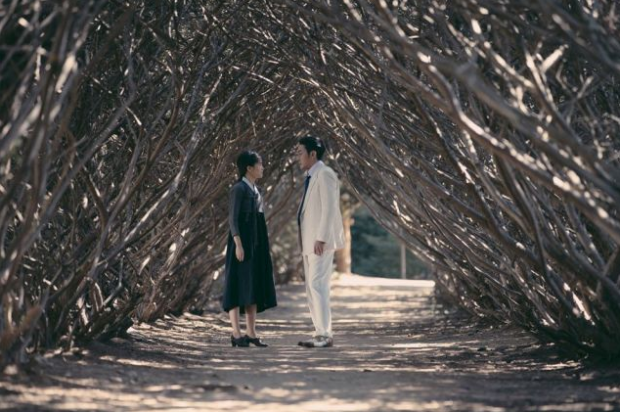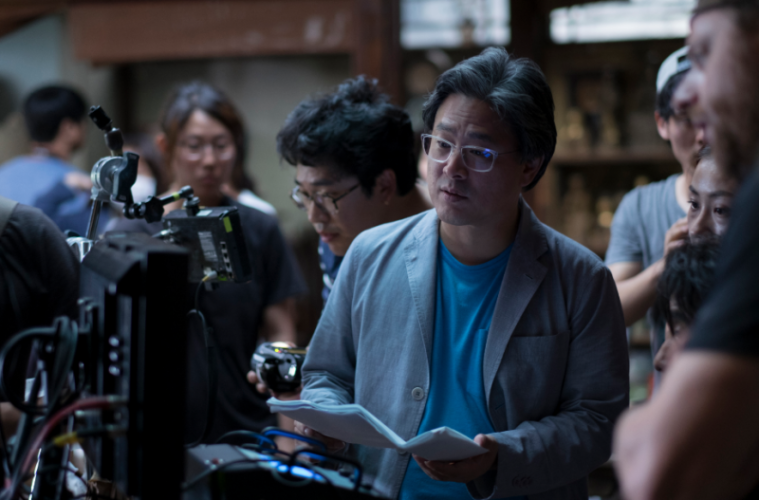
The Handmaiden is, in some way, the über Park Chan-wook film — revenge! double-crosses! violence! eyebrow-raising sex scenes! wild angles and edits! — thus making it a perfect occasion to speak with South Korea’s best-recognized auteur. That I don’t especially love his latest picture and, still, found myself eager to speak with him about its particulars should be a testament to the level of interest it affords. When, for instance, was the last time a filmmaker could reasonably answer questions about the use of subtitles?
When we get into the film’s sexual politics — a major point of contention in our Cannes review — it’s clear that Park feels a deep need to defend his material and artistic perspective, but the conversation remained cordial as he paced back and forth in a Manhattan hotel room. I’ll let you discover the rest for yourself.
I’d like to thank Wonjo Jeong, who provided excellent on-site translation.
The Film Stage: Following the English-language Stoker, did you feel some relief in returning to your native tongue — even a reacquaintance of sorts?
Park Chan-wook: Well, I never thought about it, but since now that you ask and I think about this, maybe that’s the reason why The Handmaiden has the most dialogue of all of my films. Maybe, in returning to this language I’m so comfortable and familiar with, I thought, “I will use it as much as I can.” Well, I’m not so sure. The amount of the dialogue is partly because, in the process of condensing the original novel [Sarah Waters‘ Fingersmith] into a feature length, I had to give a lot of information through dialogue. That’s probably the reason. Fundamentally, though, a movie set — whether you find yourself in Korea or the states — is the same.
I wonder if that created an extra dimension of play in the interchanging between Korean and Japanese dialogue, which has a major part here.
That’s right. It’s a situation that’s not found in the original novel, and there’s some fun to be had, because of the mix of the two languages — that would come across a little differently for anyone who doesn’t speak either of the languages. But, hopefully, the fun side of playing with the two languages still would’ve come through in the different-colored subtitles. For example, in the torture scene at the end, Uncle Kouzuki is using the Korean language, which, up to that point, he hadn’t used. It’s a funny situation, because here’s a character who worships Japanese so much that he insisted, always, on using the Japanese language, but after his collection has been destroyed and his life’s work was all gone, he’s in this mentally destroyed state; he’s now using the Korean language.
But even while he is using Korean, he would use some words of Japanese — and it was the actor, Cho Jin-woong’s, idea to do that, and I thought that was brilliant. And it was his idea that, during the colonial era, there would’ve been Korean intellectuals who would speak in this way, just like some of the intellectuals nowadays are doing: when they speak Korean, for instance, they will sprinkle little English words here and there — a conjunctive word here, a preposition there, or something like that.

The different-colored subtitles, with white for Korean and yellow for Japanese, are a great pleasure. I’d like to know at what point you realized this approach would be taken.
That was decided during post-production. We got to the stage where we had to subtitle the film; I thought about how to best present that there are two languages in the film and a play between the two, because I didn’t want the overseas audience to miss out on any bit of enjoyment from that.
What about showing the same scene from multiple angles? In terms of scheduling and, when it comes to perspectives, camera set-ups. The scene in a tree-lined path comes to mind.
Well, the scheduling was all strictly centered on the different locations that we were shooting. For instance, in the scene you reference, that was all done around the same time — when Kim Min-hee was there for shooting. It’s something that’s made possible when you do a thorough storyboard, and, in terms of performance, I would ask the actors to not do anything different for the first part and the second part, and we would achieve the perspective through the positioning of the camera and such. But, on some shots, I would ask for the performance to be slightly different. Those kinds of things we would try to figure out when we were doing a reading with the actors. Right now, I can’t think of any such moments in the release version, but there are moments like that in the extended version — shots where I asked the actors to give a slightly different performance just because of the different perspective. So it’s probably something you’ll find on the Blu-ray.
Your co-writer, Chung Seo-kyung, has a queer friend who informed the writing and perspective of this story. Ultimately, what role did they play in shaping the final film?
I haven’t conducted all the conversations with her queer friend myself. It was my co-writer who talked the most with her friend about all the different iterations about the script, and, whenever that happened — whether her and her friend say, “Well, you can change certain things this way,” or, “This is good” — I can’t really remember. I wasn’t part of all the details of that conversation. Right now, something I do remember and can give you as an example is her comment about the scissor position. It was the queer friend who said, “That has to be in the film. It’s the best position.”

The Handmaiden’s couching of Asian culture and austerity within extreme subject matter recalls, for me, the Japanese New Wave, and many of its camera moves and edits brought to mind Nagisa Oshima. Were these conscious influences?
There weren’t any specific writers or filmmakers that I had in mind while I was making this film; if there were any influences, it must have been from some subconscious level. Since there are Japanese characters in it, Japanese-style house, Japanese-style costumes, and some sensual moments, I wouldn’t blame people if they think of Japanese New Wave films when they see this.
You said that, lately, you’ve had less time to watch films for yourself, being busy actually making them. Do you suspect that the decreased time for watching films might have changed you as a filmmaker?
Well, from 1999, when I started shooting JSA, I lost every right to be called a “cinephile.” But how did it affect my work? Well, you see, I can’t tell you about how things have affected me and changed me because I was doing a lot of something. But doing less* of something [Laughs] and how it “changed” me… I don’t know how to answer that question. Moreover, because I don’t have time to see many films, I tend to be very selective about what films I do see, and I end up relying on the old, classical movies and tend to see a lot of them — meaning that I don’t get to see a lot of the contemporary cinema. Maybe that means I’m behind the trend?
Years ago, you expressed interest in making a version of The Revenant, with Samuel L. Jackson as the lead. I’d love to know if you had many ideas for the material when it was in development.
I don’t know how this story has come out this way, but I don’t feel it was that long ago. At the time, I was trying to work on another western as well. I’m not even sure whether I had received the book — whether I actually ended up reading it — but, thinking about it now, I probably had read the material. But there hadn’t been any detailed conversation that had taken place on the material, and it was a situation where, even if I wanted to direct the film, there was no guarantee that I would become the director of that movie. It was just an idea that was floating around, and that was pretty much it, really. I don’t even remember that Samuel L. Jackson was attached to the project at the time.

I read an interview with you that was conducted by someone who found The Handmaiden’s “male gaze” troubling. Have many people spoken to you about those matters after seeing the film?
You know how important these reading sessions, that Hideko is part of, are for this film? These scenes are designed to literally show what “male gaze” is, and, in a very palpable manner, it shows you what the violence of gaze can do. Even if Hideko was wearing layers of kimono, it doesn’t matter; she might as well have been exposed in the nude in front of those men. So, rather than touch her, these men are meters away from the stage where she’s giving the reading — but, in these reading sessions, they might as well have been gang-raping her. So for a filmmaker who is trying to make a film about the violence of male gaze, and to make a movie that is a criticism of these kinds of violent male gaze, really, how careful we have been and how much thought we have put into designing these scenes of Hideko, who’s been the subject of such violent male gaze all her life. When she finds her true love and has this moment of love, and makes love, how careful would I have been not to make that moment yet another object of voyeuristic male gaze?
So, if you could, please consider that. I would ask, please, that you forget the fact that I am a male director and, please, try to look at the film objectively. To depict a woman as having sexual desires, in a frank manner — to be showing a nude female body, and show it in a beautiful way — does that automatically make this fall into the male gaze category? I think that’s where the problem begins, and this kind of thought, in itself, is a “male gaze” of looking at this issue. It is entirely possible for female filmmakers to depict women in their honest sexual desire and to show their nude body and the beauty of it. Female directors could just as well do that.
Someone asked what Spike Lee movie you’d like to remake, and you said Jungle Fever. I’m very curious if anything particularly attracts you to that work and a possible translation?
I would like to actually correct my answer. The reason why that answer sort of popped out of my mouth is because I was on the spot, and I was thinking, “What do I think is Spike Lee’s best film? Jungle Fever.” But if I had to remake one of his films, I would say… what’s the jazz film? Mo’ Better Blues! Mo’ Better Blues would be the better one to remake, because even if you just changed the music, it would feel like a different film. As a jazz lover, making a film like that would be such a joy.

The Handmaiden begins its U.S. release on Friday, October 21.

